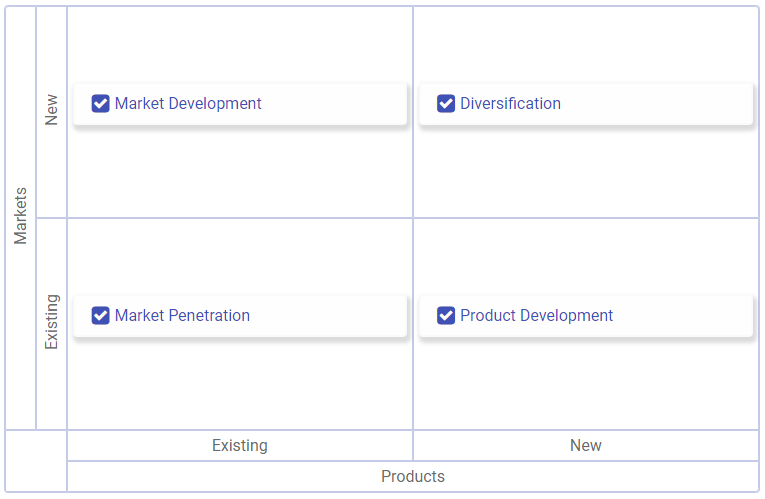Growth is a frequent and very important goal for many businesses.
Among the many benefits of growth are that it:
- creates economies of scale,
- creates employment,
- generates investor returns, and of course
- means more customers getting more of the products and services they need and want.
Growth, especially relative to competitors, is seen as a sign of success.
But it can also lead to bureaucracy, diminishing margin returns, diseconomies of scale and dispersion of focus.
H. Igor Ansoff showed with his now famous matrix in 1957, that there are at least 4 different types of growth.
 Market Penetration: selling higher volumes of the same products and services into existing markets.
Market Penetration: selling higher volumes of the same products and services into existing markets.- Product Development: developing new products or services to sell into existing markets.
- Market Development: finding new markets to sell existing products or services to.
- Diversification: selling new products or services to new markets. This is the riskiest of the four on account of it having to deal with two unknowns at the same time.
How it works
StratNavApp.com allows you to categorise your strategic growth initiatives into these four types.
Simply click on "Planning" on the main menu, and then select "Ansoff Matrix" from the selector which appears at the top of the next screen to load. (If it is not immediately visible, you may need to click on the down arrow/carat to expose it.)
From there, you can add strategic initiatives in any or all of the four growth categories, or you can drag existing initiatives from the bottom of the page onto the model.
You can also click on any initiative anywhere in the system, and edit the Ansoff Matrix attributes on the screen that loads.
How to use it
The Ansoff Matrix is useful for coming up with new growth initiatives, as well as for better understanding them - the similarities and differences between them as well as the risks they present.
Each of the 4 types of growth presents unique opportunities and challenges:
1. Market Penetration
For most businesses, market penetration is the default strategy. Of course, if the market itself is growing, then, all other things being equal, the business will grow along with it. They say that "all ships rise with the tide".
Normally, however, market penetration would seek growth relative to the market. There are a number of ways to achieve this:
- Volume-selling: selling larger quantities of the same product to existing customers. You can do this by increasing distribution and/or offering volume discounts.
- Up-selling: selling higher-value products to existing customers. For example, a more expensive model.
- Cross-selling: selling additional products to existing customers. These could be add-ons or complementary products.
- Competition: convincing customers who would otherwise have bought from your competitors to buy from you instead.
- New customer development: finding customers within the market who are not already using the product or service at all, and convincing them to start.
You can achieve market penetration by tweaking the marketing mix. That is, by reducing price, increasing promotion and/or distribution, tweaking product features or packaging, etc.
You can also achieve market penetration by acquiring a competitor.
2. Market Development
Market penetration can involve developing new markets in a number of ways:
- Entering a new geographic region. This could be a new region or country.
- Targeting a new customer segment. For example, the youth market, or small-to-medium enterprises. Success in this strategy depends on how insightful and nuanced your customer segmentation is in the first place.
- Developing new distribution channels. For example, expanding from wholesale into retail distribution, or targeting a different type of distributor.
- Expanding from the consumer to the corporate or public sectors, or vice versa.
The exact means of entering those markets will depend on numerous factors. These include different regulatory regimes, different socio-economic norms, and whether a competitor already exists in the market or not.
3. Product Development
Product development may take the form of:
- New product development: Research and innovation in order to create something which the world has never seen before.
- Product licensing: Acquire the rights to manufacture a product developed by someone else.
- Product sourcing. Select products which already exist elsewhere (in other geographies, or through other distribution channels) and make them available to your customers. Amazon is a great example of this approach.
Which of these are most suitable depends on many different factors. Key to these is whether the business is fundamentally predicated on technical product or service development expertise and innovation (like Apple), on manufacturing expertise (like Capita), or on customer intimacy (like Amazon).
New products exist in a continuum from:
- completely new and novel products, through products which are
- reconfigurations of existing products, to products which are merely
- incremental improvements to existing products.
The resulting products may be own-labelled, co-branded or white-labelled.
4. Diversification
Diversification is the riskiest of the four strategies. This is because it involves all of the complexity and risk of Market Development and Product Development at the same time.
This is why businesses often pursue diversification through acquisition. That is, by acquiring a business or team which already has a track record of selling those products or services in those markets. Even then, the acquirer's ability to understand and oversee the acquired business may be a challenge.
See also:
